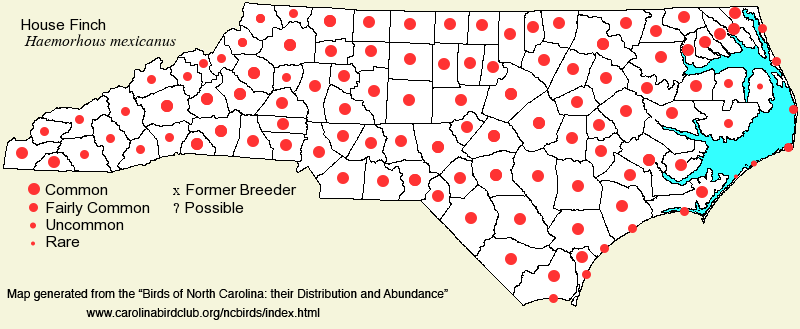 |  |
|
House Finch - Haemorhous mexicanus FRINGILLIDAE Members: | Search Common: Search Scientific: |
|
|
|||||||
| General Comments |
The House Finch, an abundant native species to the western half of the continent, was introduced in New York in 1940. It has rapidly spread southward and westward, and by the late 1960's it first appeared in North Carolina. By a decade later, it was occurring all over the state. Numbers seem to have now stabilized, and it has been a resident over all of the state for the past few decades. At all seasons it favors sites near man -- cities, semi-wooded residential areas, towns, and farms. Birds nest in shrubs and other low vegetation, and feed on the ground or in low vegetation, typically in open or semi-open country. House Finches congregate into flocks in fall and winter, though it is not clear if these flocks represent local birds or whether there is some southward movement of birds from north of the state. Mixed flocks of House Finches in winter often include various sparrows, American Goldfinches, and other species.
NOTE: The genus name was changed from Carpodacus to Haemorhous in 2012. | ||||||
| Breeding Status | Breeder; Introduced | ||||||
| NC BRC List | Definitive | ||||||
| State Status | |||||||
| U.S. Status | |||||||
| State Rank | SE | ||||||
| Global Rank | G5 | ||||||
| Coastal Plain | Permanent resident; possibly still increasing. Migratory movements uncertain. Common over nearly all of the region, including on barrier islands where settled by man; probably least numerous on barrier islands where there are no human settlements. First record was at Morehead City in 1972. Peak counts: | ||||||
| Piedmont | Permanent resident; population seems to have stabilized in recent decades. Common to abundant over the region, most numerous in cities and large towns. First records, at several towns, in 1966. Peak counts: | ||||||
| Mountains | Permanent resident; populations probably stabilized in recent decades. Fairly common to locally common in cities at lower elevations (below 2,500 feet), but at best uncommon to fairly common at low elevations away from such large towns and cities, as well as in middle elevation towns (to 4,000 feet), and scarce or absent at high elevations. First record apparently at Swannanoa (Buncombe) in Oct 1975. Peak counts: | ||||||
| Finding Tips |
None needed. **** | ||||||
| Attribution | LeGrand[2023-03-28], LeGrand[2018-02-01], LeGrand[2012-11-09] | ||||||
| NC Map Map depicts all counties with a report (transient or resident) for the species. | Click on county for list of all known species. |
| NC Breeding Season Map Map depicts assumed breeding season abundance for the species. |  |